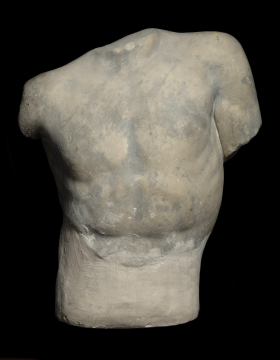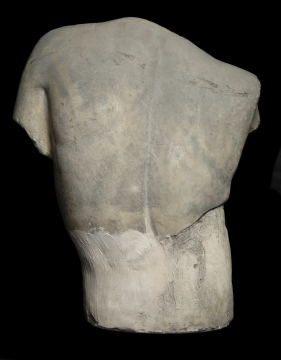Explore Collections


You are here:
CollectionsOnline
/
Fragmentary Graeco-Roman torso of a half-kneeling niobid
Browse
Curatorial note
A sketch of a proposed pedestal for this piece, drawn by Joseph Bonomi (Curator of Sir John Soane's Museum 1861-1878) and water-marked 1863, shows that the identification of it as a Niobid was made as early as this date. Since Bonomi was probably ill at the time of Michaelis' visit (1877) or had forgotten about the drawing, the latter did not know of this discovery when he described the marbles in the Soane Museum.
This torso is a replica of the torso of one of the figures of the well known Niobid groups in Florence and individual statues scattered throughout the museums of Western Europe; this particular figure is the half-kneeling, half falling youth who turns his head up toward his divine slayers as he supports himself on the rocky earth to which he is about to sink. The weight rested on his left arm, and the right was back with the fist, clenched in agony, brought forward and resting on the thigh.
There are two replicas of this particular figure in the Uffizi Gallery, Florence (nos. 289, 290; Photo Alinari nos. 1282, 1283; Amelung, Führer, nos. 178 (254), 179 (253), both with their heads and arms unbroken. An inferior and restored figure is in the gallery to the right of the entrance of the Museo Capitolino, Rome (Jones, Cap., p.121f., no.48, pl.21, fig.48), and a poor copy of the head is in the Museo Chiaramonti of the Vatican (Amelung, VC, I, p.565, no.389, pl.59).
Of the various Niobid figures, from its well balanced composition, from its force as an entity, and from its particularly pathetic appeal, this statue was perhaps popular as a figure alone. The Niobid statues are antique copies of a group belonging to an ensemble of sculptures representing the massacre of the sons and daughters of Niobe by Apollo and Artemis. They are most recently dated (Louvre, label to no. 1339; Amelung, Führer, fig.33; Löwy, in JDAI, XLII, 1926, pp.80ff., esp. pp.93f., fig.13) to the end of the fourth century BC. This Soane torso is excellent sculpture, a replica of very high quality, certainly work of the Augustan or Julio-Claudian periods if not earlier.
The popularity of single Niobids also holds true for figures from the pediment or freestanding group carved (the original) about 410 to 390 BC, as the falling Niobid at Malibu, California: C. Vermeule, N. Neuerburg, op.cit. (no.365), pp.12-13, no.22. The Florence Niobids may be creations of the first century BC; B.S. Ridgway, Hesperia, XL, 1971, p.351.
This torso is a replica of the torso of one of the figures of the well known Niobid groups in Florence and individual statues scattered throughout the museums of Western Europe; this particular figure is the half-kneeling, half falling youth who turns his head up toward his divine slayers as he supports himself on the rocky earth to which he is about to sink. The weight rested on his left arm, and the right was back with the fist, clenched in agony, brought forward and resting on the thigh.
There are two replicas of this particular figure in the Uffizi Gallery, Florence (nos. 289, 290; Photo Alinari nos. 1282, 1283; Amelung, Führer, nos. 178 (254), 179 (253), both with their heads and arms unbroken. An inferior and restored figure is in the gallery to the right of the entrance of the Museo Capitolino, Rome (Jones, Cap., p.121f., no.48, pl.21, fig.48), and a poor copy of the head is in the Museo Chiaramonti of the Vatican (Amelung, VC, I, p.565, no.389, pl.59).
Of the various Niobid figures, from its well balanced composition, from its force as an entity, and from its particularly pathetic appeal, this statue was perhaps popular as a figure alone. The Niobid statues are antique copies of a group belonging to an ensemble of sculptures representing the massacre of the sons and daughters of Niobe by Apollo and Artemis. They are most recently dated (Louvre, label to no. 1339; Amelung, Führer, fig.33; Löwy, in JDAI, XLII, 1926, pp.80ff., esp. pp.93f., fig.13) to the end of the fourth century BC. This Soane torso is excellent sculpture, a replica of very high quality, certainly work of the Augustan or Julio-Claudian periods if not earlier.
The popularity of single Niobids also holds true for figures from the pediment or freestanding group carved (the original) about 410 to 390 BC, as the falling Niobid at Malibu, California: C. Vermeule, N. Neuerburg, op.cit. (no.365), pp.12-13, no.22. The Florence Niobids may be creations of the first century BC; B.S. Ridgway, Hesperia, XL, 1971, p.351.
Unrecorded
Literature
Michaelis, p. 474, no. 5
Elisabeth Wiesmann, Der Mythos von Niobide und ihren Kindern, Studie zur Darstellung und Rezeption, Worms, 1986
Elisabeth Wiesmann, Der Mythos von Niobide und ihren Kindern, Studie zur Darstellung und Rezeption, Worms, 1986
Soane collections online is being continually updated. If you wish to find out more or if you have any further information about this object please contact us: worksofart@soane.org.uk





